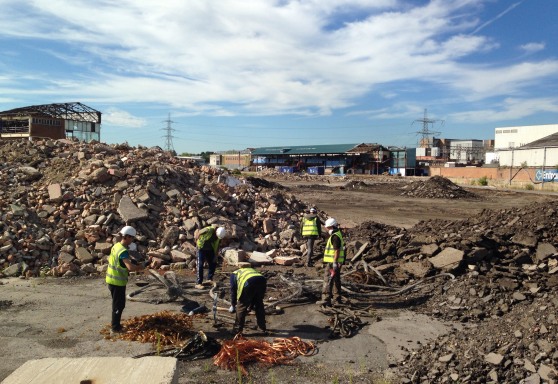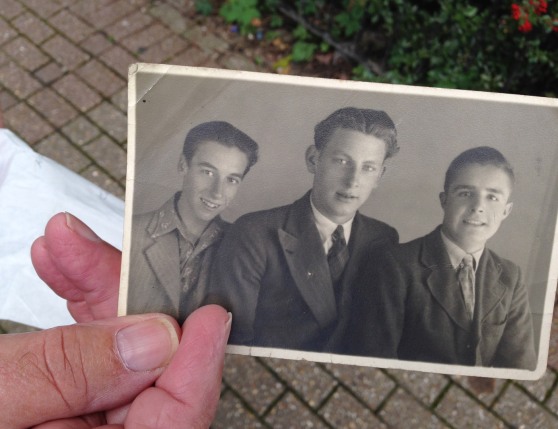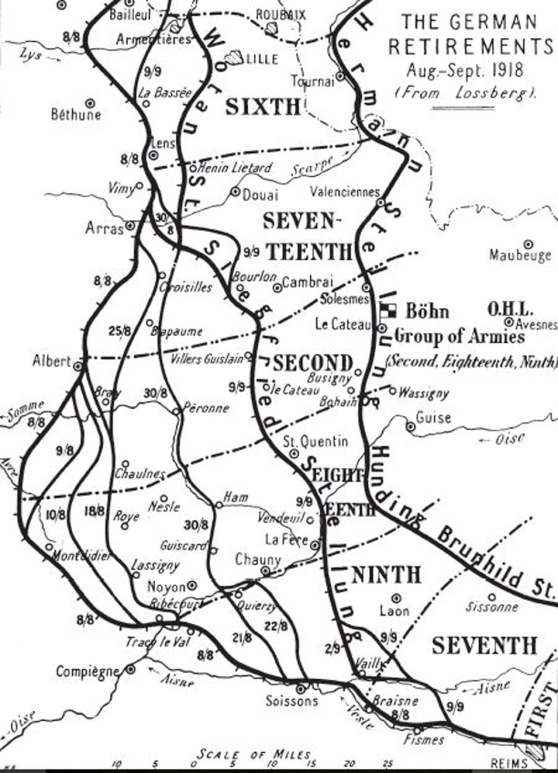





Albert Elliot’s home was very close to St Mary’s Church at No5 Wimbledon Road just a few doors away from the Carrigan household at No11. The young painter’s labourer and decorator would surely have known the leather grounder who was just a few years older. Both families originally lived on Summerstown before relocating to Wimbledon Road. The Elliot home along with all the houses on the south side of Wimbledon Road on the edge of the Hazelhurst estate disappeared in the decades after the Second World War. Many of them were damaged in the bombings of 1940-41. The above photo looks down towards the almshouses and No5 would be roughly where the horse and cart can be seen. Note the distinctive tall chimneys on the almshouses. This is the view today and the house was probably somewhere around the entrance to Burfield Close. Its very likely that the apple and pear trees down here at the back of the almshouses which produce a heavy crop each September would have been yielding their fruit in Albert’s day.

In 1901 the family lived at 85 Summerstown, one of the Sadlers Cottages, very close to the White Lion pub. Just across the road, opposite the Summerstown Mission was an off licence known as the Prince Albert. At this stage William Elliot worked as a copper varnisher and later as a builder’s labourer. Its very hard to imagine that his hands would not have been involved in the construction of houses in the nearby Fairlight streets or even the magnificent St Mary’s Church arising at the end of the new Keble Street and directly in line with his home. A photo from 1968 shows the cottages and the pub on one of the famous occasions that the River Wandle burst its banks. They would have disappeared soon after this and the site opposite the rapidly disintegrating Wimbledon Stadium is now a rather characterless early seventies block. It is though home to another church, The Redeemed Christian Church of God. Possible candidates for the next Multifaith Tour perhaps.



William Elliot was born in Westminster in 1862. He got married in 1884, his wife Mary hailed from Dunstable in Bedfordshire. Their eldest child William was born in Lambeth in 1887. By 1896 they were in Wandsworth where Albert Edward was born. In 1901 they were resident in Summerstown. Mary worked as a laundress and they had three boys; William 14, Albert 5 and Sidney aged 1. We can’t be sure when they moved to Wimbledon Road but they must have taken great pride at the splendid new Church opposite their home. After eleven years in a temporary tin church located at the end of Summerstown, opposite the Corner Pin. It must have been a wonderful moment for everyone in the area when Queen Victoria’s daughter came to lay the foundation stone and the new structure opened its doors for the first time in April 1904.



By 1911 a fourth son had been born to William and Mary, Frederick in 1907. The two oldest boys, William and Albert both worked like their father in the building trade. Albert would have been eighteen when the war broke out and prime material to end up in uniform. We haven’t found his service records, all we know is the he was a gunner in ‘F Battery’ 14th Brigade of the Royal Horse Artillery and died on 24th August 1918. Military historian Chris Burge has deduced from the few documents that survive, a little bit about his army career. When he died, Albert’s legatee, his mother, received a £19 war gratuity which would imply he had served from near the beginning of the war. This is consistent with his entry in the Surrey Recruitment Register which shows him volunteering on 29th August 1914 in Kingston and first going to France on 24th February 1915. He rests in a small cemetery south-west of Arras along with another local boy, Fred Neary from Foss Road, who is also on our memorial. Serving in the Lincolnshire Regiment, he was killed thirteen days earlier. There are only 221 burials in this tranquil spot. We visited St Amand British Cemetery on a dazzling October evening a few years ago. As so often happens when we make these trips, the yellow and brown autumnal hues came together in a glorious golden fusion, a stunning backdrop for the glimmering headstones beneath the bluest of skies. Albert was one of seven F Battery casualties all buried together, including Lieutenant Clifford Gould MC from Glastonbury who at 21 was a year younger than the lad from Summerstown.


One of the magical occasions which have happened so often on the Summerstown182 Walks over the past four years occured in September 2015 when four members of the White/Elliot family rolled up for one of the tours. Reg White was there with his daughter Teresa Elliot. He lived at No1 Wimbledon Road, his mother’s maiden name was Elliot believed to be related to the Elliots who were at No5. He produced an old photo taken about sixty years ago which showed him with a couple of his pals. One of these was Arthur Keeley, the older of the two brothers who unveiled the Hazelhurst V2 plaque no less. We promised to put them in touch which was exciting enough but imagine Reg’s face when another old Hazelhurst pal, Dudley Hutchinson walked round the corner. It really was quite a way to start the tour.
















